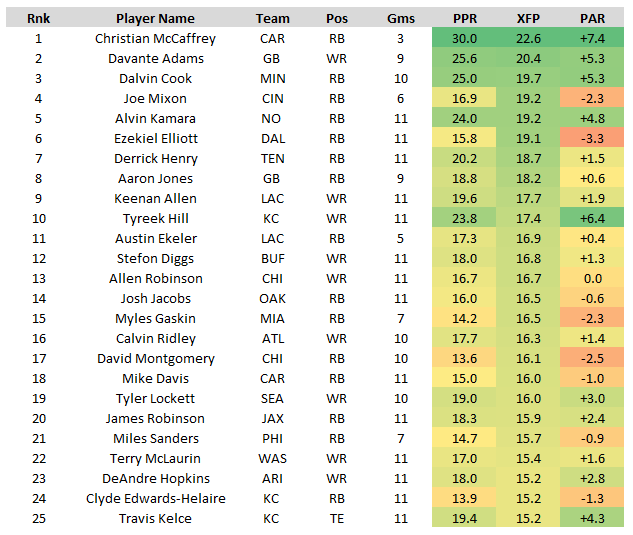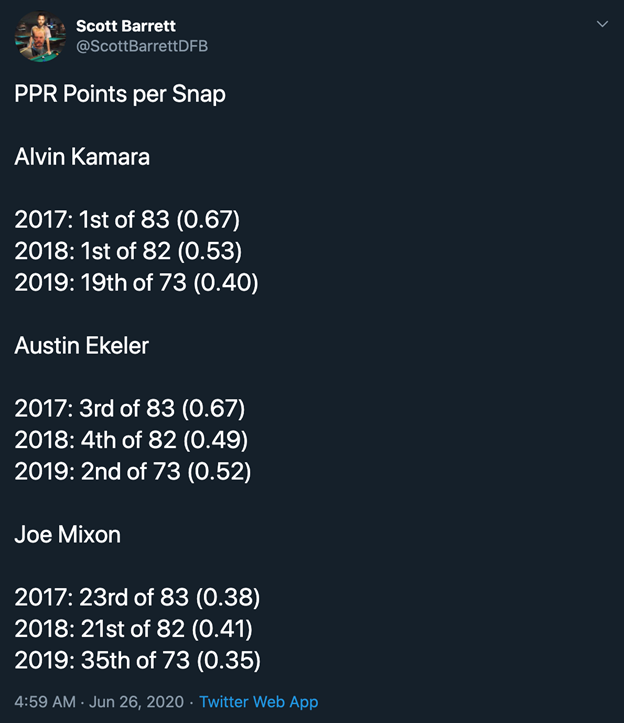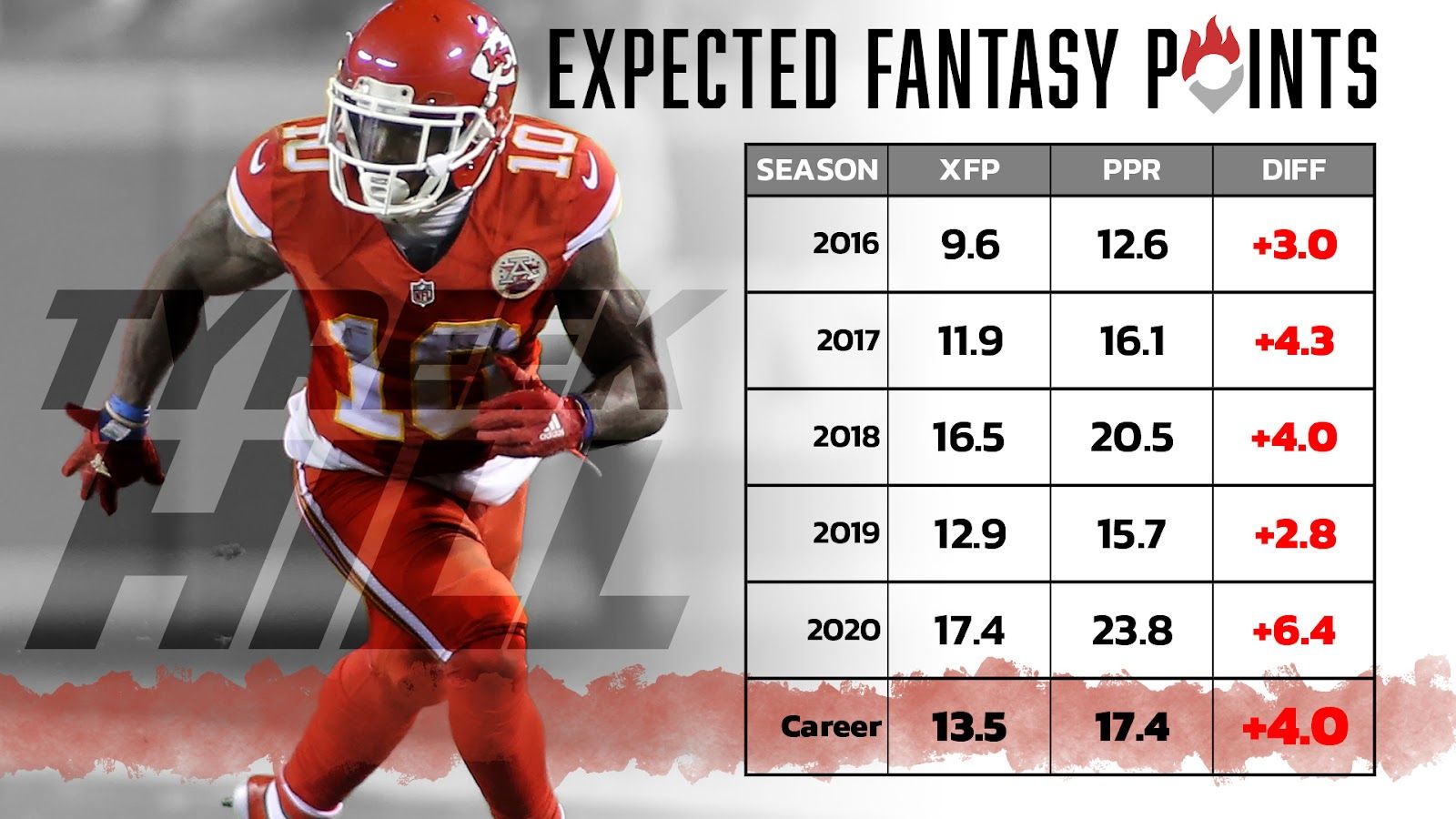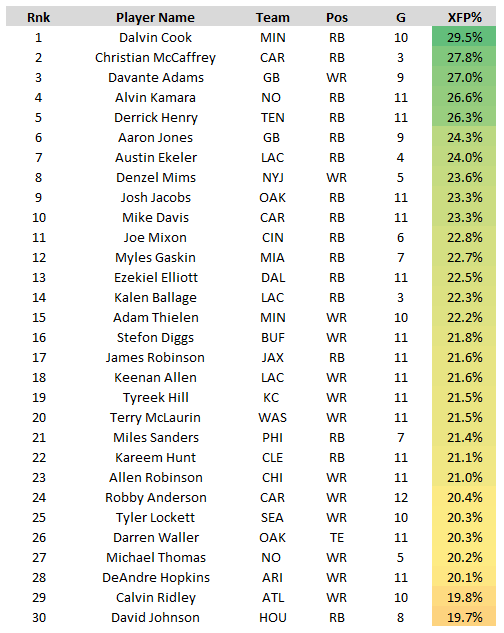Hello, and welcome to the Week 13 XFP Report. If you’re unfamiliar with XFP, I’ll get to that in a little bit.
But basically, every week we’re going to be telling you which players are seeing the best volume for fantasy, as measured by Expected Fantasy Points (XFP). We’ll be telling you who the best buy-low and sell-high candidates are, as measured by Points Above Replacement (PAR), or the differential between actual- and expected fantasy points. This is an especially effective approach in DFS, where players are typically priced by production rather than volume, though PAR will regress to the mean. And (at the end of the article) we’re going to be telling you who the best volume-per-dollar DFS plays are.
What is XFP?
Premium subscribers can access XFP (and other advanced stats like air yards, deep targets, end zone targets) here.
Expected fantasy points (XFP) is flat-out the best and most comprehensive way of measuring a player’s volume. It’s telling you – based on a player’s unique usage – how many fantasy points that player should have scored. It’s telling you how many fantasy points a perfectly league-average RB, WR, or TE would have scored with that same exact volume. It looks at every individual carry by down and distance and distance from the end zone and every individual target by depth of target and distance from the end zone, and then cross-references each carry and target to each carry and target with those specific qualifiers over a multi-year sample to tell you what exactly those carries and targets are worth (historically).
Expected touchdowns (XTD), same thing. RBs score from the one-yard line on 54% of their attempts. RBs score from the 17-yard line only 3.6% of the time. So why ever use “red zone carries,” which treats both carries the same, as a fantasy stat? I have no idea.
Why doesn’t everyone point to XFP in their fantasy research? I have no idea. Once you have XFP and XTD you can contrast that with a player’s actual fantasy points or actual touchdown total to tell you how efficient a player has been (PAR). This is especially useful in highlighting regression candidates, buy-low targets, and mispriced players for DFS.
Through 12 weeks of action, here are the top-25 players in expected fantasy points (XFP) per game:
The Top-25
Notes: We’re currently missing Monday and Wednesday night’s games from our sample. We’ll have that updated when they come in, here.
Austin Ekeler, RB, Los Angeles Chargers
PPR: 17.3, XFP: 16.9, PAR: +0.4
Heading into Week 12, Ian Rapoport reported Ekeler “would not be the bell cow just yet.” And sort of like when he said James Conner would be in a committee in Week 2, or that Christian McCaffrey would be in a committee in Week 9, or that Jalen Hurts would see a major upsurge in usage in Week 12,,,, he was wrong. Yeah, for future reference, feel free to safely ignore any of his reports that are not also backed up by Adam Schefter.
Ekeler was a bell cow in Week 12, with Kalen Ballage out, playing on 73% of the team’s snaps (5th-most on the week), and earning 14 carries and 16 targets. Better yet, he led all players in XFP, totaling 35.3. He wasn’t very efficient on that good volume, scoring just 23.9 fantasy points, but this was about a week early as it relates to his injury timeline, and he’s long been one of the most efficient RBs in fantasy, so don’t be too concerned in that regard.
Through 4 healthy games, Ekeler is averaging 15.3 carries, 8.0 targets, 20.5 XFP, and 21.0 FPG. If over a full season, those numbers would rank 12th, 1st, 2nd, and 4th-best among RBs. In other words, he’s seeing even better usage than he saw through the first 4 weeks of last season during Melvin Gordon’s holdout. Over that stretch, he averaged 26.8 FPG – the only player coming anywhere near Christian McCaffrey during that span. He averaged 71% of the snaps (vs. 67% now), along with 14.0 carries and 6.3 targets per game. From Weeks 5-17, those numbers dropped to 53%, 6.3, and 6.9, respectively. And still, he rounded out that stretch ranking 5th in total fantasy points, averaging 16.8 FPG.
Might he be a league-winner down the stretch and through the fantasy playoffs in 2020? I think the chances are high.
James Robinson, RB, Jacksonville Jaguars
PPR: 18.3, XFP: 15.9, PAR: +2.4
Robinson went undrafted in 99% of leagues this offseason, but he’s emerged as a quiet superstar and a likely league-winner for those of you who secured him off waivers early in the season.
Robinson played on 97% of the team’s snaps in Week 11, and he ranks 1st in Snap% since Week 7 (88%). With Chris Thompson on I.R., he’s now a full-on bell cow, and maybe the best example of a true bell cow we have this year. And, for fantasy, that goes a long way. Jacksonville is terrible, game script is consistently horrible, the offense is bad, and the offensive line is even worse. And yet, I’m confident Robinson continues to produce as a mid-range RB1. Why? Because a bell cow RB is the most valuable asset in fantasy.
Robinson ranks 4th among all RBs in fantasy points, averaging 18.3 FPG. He ranks 7th in total XFP, averaging 15.9 XFP per game. Since Week 7, he ranks 3rd in XFP per game (18.3) and 3rd in FPG (19.5). He’s reached at least 90 yards from scrimmage in each of his 5 games over this span, and has hit that mark in 9 of 11 games this year. Start him as a top-6 fantasy RB against Minnesota this week.
Antonio Gibson, RB, Washington Football Team
PPR: 16.9, XFP: 13.4, PAR: +3.5
Gibson isn’t quite a bell cow, but his Week 12 usage was highly encouraging, and a full-on bell cow workload with league-winning upside has always been in his range of outcomes. Though Gibson had over twice as many career receiving yards as career rushing yards in college, J.D. McKissic had over twice as many targets as Gibson heading into last week.
In Week 12, Gibson saw season-highs in Snap% (67%), Route% (61%), rushing attempts (20), targets (7), XFP (21.8), and fantasy points (36.6). For comparison, McKissic saw just 1 carry and 2 targets. Of course, game script (a 25-point win) benefited him far more than McKissic, but this was all still highly encouraging. My favorite comp for him coming out was pre-injury David Johnson, and I think there’s a chance he’s gifted a bell cow workload and goes Super Saiyan down the stretch (especially with Captain Checkdown Alex Smith under center), as Johnson did in his rookie season.
Week 13 – as 10.0-point underdogs against the league’s toughest run defense (Pittsburgh) – will be a good test.
Tyreek Hill, WR, Kansas City Chiefs
PPR: 23.8, XFP: 17.4, PAR: +6.4
Hill has always stood out as something of an XFP outlier. He’d routinely rank top-5 in FPG, but somewhere around 15th in XFP per game. Numbers like that rarely happen. But then again, players like Hill are just as rare. That’s because he’s inarguably the most efficient WR in fantasy, consistently ranking 1st in PAR. Since entering the league in 2017, Hill has out-scored his per-game expectation by +3.0 (2016), +4.2, +4.0, +2.8, and +6.4 (2020). Collectively, he’s outscored his expectation by +4.0 FPG or by 130% -- in other words, he’s 130% better than a perfectly league-average player.
Clearly, the talent has always been there for Hill. Volume was the only thing standing in the way of him being – I don’t know – let’s say, the most valuable player in fantasy, instead of just a top-3 WR asset. But now he’s finally seeing elite levels of volume.
He’s ranked top-3 in XFP in each of his last 3 games. Since Week 7, he ranks 1st in XFP per game (30.3), with 8.7 more than the next-closest player (Dalvin Cook). He ranks 1st in FPG over the same span (39.3), with 15.4 more than the next-closest player (Davante Adams). Hill has now seen 47 targets over his last 3 games, with a low of 14 targets in Week 11. He’s scored 8 touchdowns over his last 4 games, and has scored at least once in 10 of 11 games.
Will this continue? It’s hard to say. This newfound boost to truly elite levels of volume is highly encouraging. As is the fact that Kansas City ranks as the most pass-heavy team over expectation since Week 7 – passing on 69% of their plays versus an expectation of 51% (accounting for gameflow and down and distance). What’s his upside? His upside is Exodia. If this volume continues, he could be one of those players where it’s nearly impossible to have won your fantasy championship without him. As a worst-case scenario, he just goes back to who he was before – an easy top-5 fantasy WR.
Deebo Samuel, WR, San Francisco 49ers
PPR: 13.2, XFP: 12.2, PAR: +1.0
Samuel ranked 8th in XFP in Week 12 (19.5), totaling 13 targets but just 6.0 total air yards. Over his last 3 games, he’s averaging 1.3 carries, 8.0 targets, -9.3 air yards, 14.3 XFP, and 18.2 FPG. It’s pretty wild to see Samuel draw basically gadget-type usage, but then again manufactured touches are not a bad thing, and he has been producing with that volume. Remember, air yards are pretty overrated in fantasy football. Deep targets are more valuable than short passes, but not by much, and there is more volatility there. But all of this gets captured into a player’s XFP anyway. Just try to think of Samuel as a high-floor / low-ceiling play, and with this usage, feel free to totally ignore his CB schedule.
Kenyan Drake, RB, Arizona Cardinals
PPR: 13.7, XFP: 14.7, PAR: -0.9
Drake was 0.07 XFP away from hitting a new season-high in XFP in Week 11 (16.0), totaling 11 carries, 5 targets, and 2 opportunities inside the 5-yard-line. He smashed that number in Week 12, totaling 29.5 XFP on the back of 22 carries, 4 targets, and 5 opportunities inside the 5-yard-line. However, it’s still a little too early to get excited – he played on only 55% of the team’s snaps over this span. Needless to say, I’m doubtful he turns things on down the stretch and reminds us all why we were drafting him top-25 over the summer.
Jakobi Meyers, WR, New England Patriots
PPR: 11.5, XFP: 11.3, PAR: +0.2
Meyers is seeing elite volume. Since Week 7, he’s maintained a 33% share of his team’s receiving XFP. Davante Adams currently leads the league with 34%, just ahead of Adam Thielen (31%). Unfortunately, New England is the 3rd-most run-heavy team in the league, so it hasn’t exactly translated into a lot of fantasy points. And he’s still tough to trust in season-long, but he’ll be a popular bring-back on Chargers-stacks in DFS this week. He averages 8.2 targets, 13.2 XFP, and 14.2 FPG over his last 5 games. Across the full season, he ranks 9th in PFF Receiving Grade (84.3) and 6th in YPRR (2.46).
Taysom Hill Fallout
Michael Thomas comprises 54% of New Orleans’ receiving XFP since Taysom Hill took over as starter in Week 11. Like Meyers, it hasn’t really translated, but it is encouraging. Hill has thrown 39 times, and Thomas was the intended receiver on 17 of those throws (43.6%). If Hill does anything through the air against Atlanta this week, it’s hard to imagine Thomas doesn’t post a big game. However, it’s a bit more difficult to imagine Jared Cook or Alvin Kamara come away as week-winners.
Over their last 3 games, Jared Cook totals just 6 receiving yards on 61 snaps. That’s 21 fewer yards and 36 fewer snaps than Adam Trautman over the same stretch.
Similarly, Latavius Murray has out-played Kamara in back-to-back games. Over this span, Murray totals 36.1 fantasy points, 19.9 XFP, and 59 snaps to Kamara’s 16.7 fantasy points, 17.8 XFP, and 62 snaps. And I don’t think this is purely coincidental – at the very least it wouldn’t be the first time a dual-threat QB totally tanked the fantasy value of an elite pass-catching RB.
D’Andre Swift, RB, Detroit Lions
PPR: 14.2, XFP: 12.3, PAR: +1.9
Here’s what we said about Swift a few weeks ago:
“Since Detroit’s Week 5 bye, D’Andre Swift ranks 5th in FPG (17.2) and 8th in XFP per game (14.9). He totaled 16.3 XFP in Week 10, slightly above his Week 9 total of 15.6, but below his season-high of 19.9 in Week 6. However, more importantly, that 16.3 XFP represented a season-high 81.9% share of the team’s backfield XFP. From Weeks 1-9, he earned just 46% of the backfield XFP. If he handled a 81.9% share of the backfield XFP all season, he’d be averaging 20.3 XFP per game, which would rank 4th-most among RBs.”
Myles Gaskin, RB, Miami Dolphins
PPR: 14.2, XFP: 16.2, PAR: -2.3
Here’s what we said about Gaskin a few weeks ago:
“Through the first 4 weeks of the season, Gaskin averaged 14.1 XFP per game, commanding a 53% XFP share of Miami’s backfield. Over the next 4 weeks (with Jordan Howard ruled a health-scratch in each game), Gaskin averaged 19.7 XFP per game with a 77% share of the team’s backfield XFP. For perspective, that’s the difference between ranking 21st-and 6th-best at the position. He wasn’t super-efficient on that good volume (-2.3) but was good enough to be ranked as a fringe RB1 each week. Unfortunately, he’ll be sidelined for the next 4 weeks with a sprained MCL.”
Top DFS XFP Values (DraftKings)
- Darnell Mooney, WR ($3,400)
- David Montgomery, RB ($5,500)
- Anthony Miller, WR ($3,100)
- Kenyan Drake, RB ($5,700)
- Cooper Kupp, WR ($6,100)
- Josh Reynolds, WR ($4,200)
- Chase Claypool, WR ($6,300)
- Denzel Mims, WR ($4,100)
- Breshad Perriman, WR ($3,900)
- Allen Robinson, WR ($6,700)
- Logan Thomas, TE ($3,400)
- T.J. Hockenson, TE ($5,000)
- Evan Engram, TE ($4,900)
XFP Market Share Leaders











